HC2121 Comparative Business Ethics: Gender Discrimination Analysis
VerifiedAdded on 2023/06/03
|8
|1989
|300
Essay
AI Summary
This essay examines gender discrimination in the workplace, focusing on a recent news article highlighting the issue. It summarizes arguments about gender pay gaps, sexual harassment, and the underreporting of these incidents. The essay discusses key ethical concerns, including corporate governance and social responsibility, and evaluates whether appropriate ethical decisions have been made. It also analyzes relevant government policies and corporate actions, suggesting improvements like stricter laws and revised HR policies. The analysis aligns with the common good approach, emphasizing the need for a safe and equitable work environment for all, and advocating for government and corporate accountability in addressing gender discrimination.
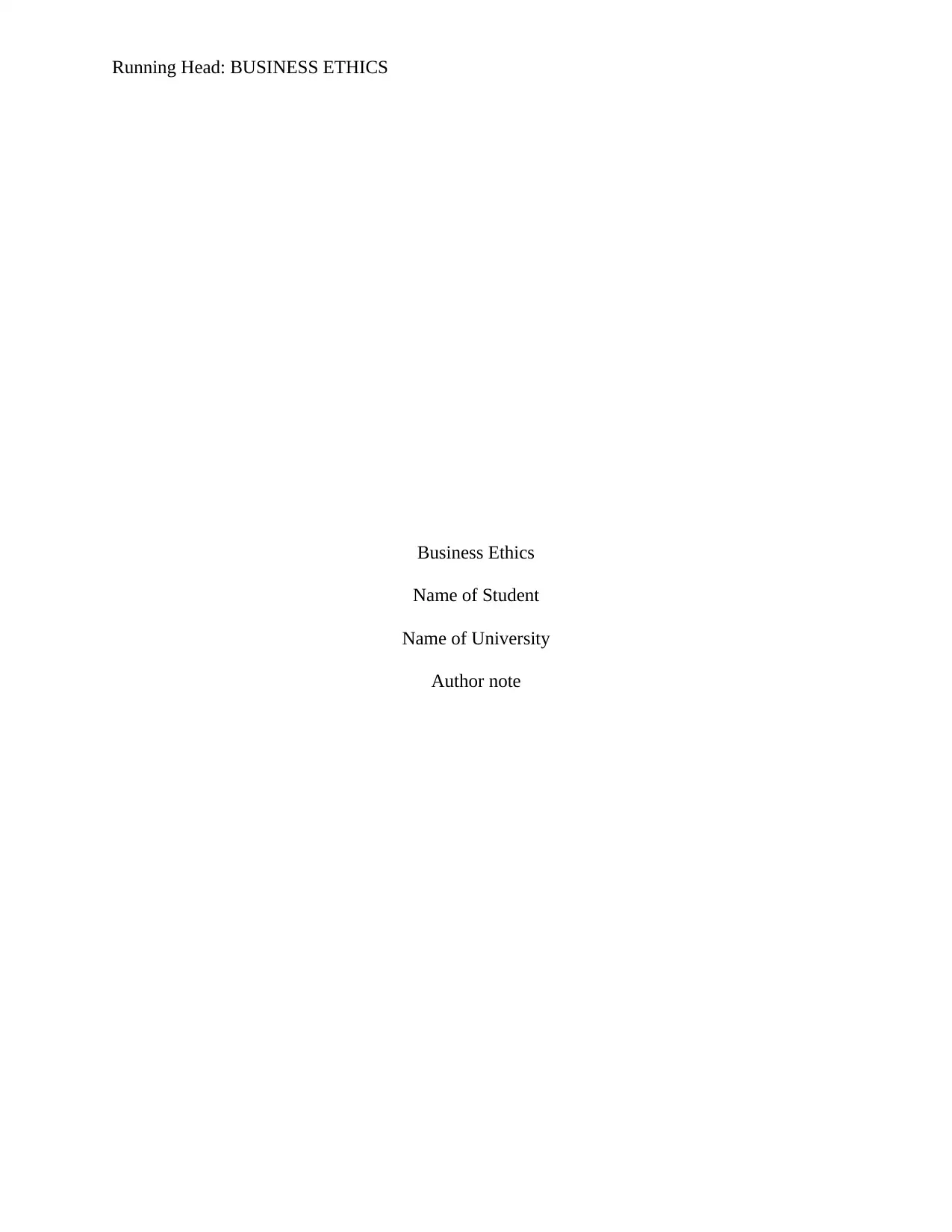
Running Head: BUSINESS ETHICS
Business Ethics
Name of Student
Name of University
Author note
Business Ethics
Name of Student
Name of University
Author note
Paraphrase This Document
Need a fresh take? Get an instant paraphrase of this document with our AI Paraphraser
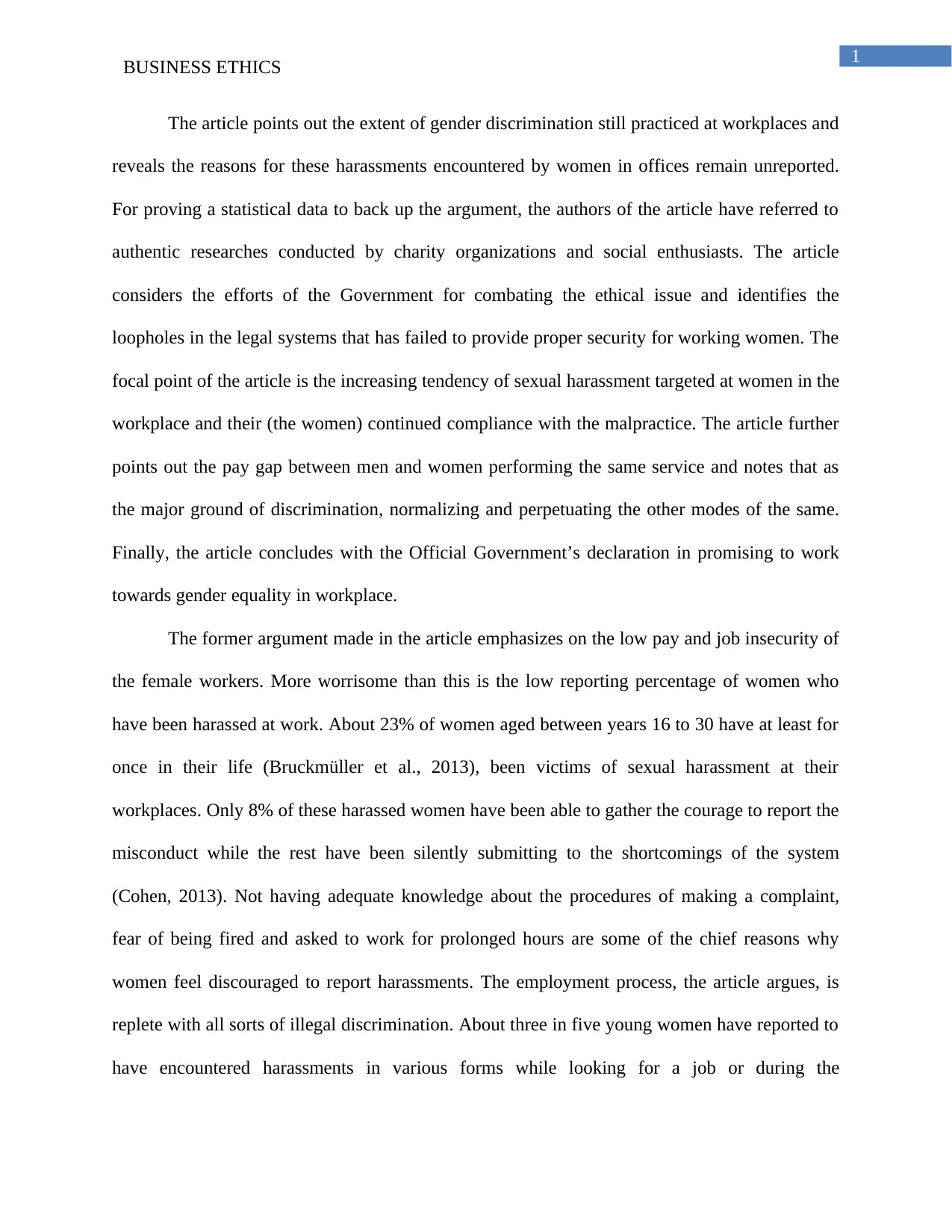
1
BUSINESS ETHICS
The article points out the extent of gender discrimination still practiced at workplaces and
reveals the reasons for these harassments encountered by women in offices remain unreported.
For proving a statistical data to back up the argument, the authors of the article have referred to
authentic researches conducted by charity organizations and social enthusiasts. The article
considers the efforts of the Government for combating the ethical issue and identifies the
loopholes in the legal systems that has failed to provide proper security for working women. The
focal point of the article is the increasing tendency of sexual harassment targeted at women in the
workplace and their (the women) continued compliance with the malpractice. The article further
points out the pay gap between men and women performing the same service and notes that as
the major ground of discrimination, normalizing and perpetuating the other modes of the same.
Finally, the article concludes with the Official Government’s declaration in promising to work
towards gender equality in workplace.
The former argument made in the article emphasizes on the low pay and job insecurity of
the female workers. More worrisome than this is the low reporting percentage of women who
have been harassed at work. About 23% of women aged between years 16 to 30 have at least for
once in their life (Bruckmüller et al., 2013), been victims of sexual harassment at their
workplaces. Only 8% of these harassed women have been able to gather the courage to report the
misconduct while the rest have been silently submitting to the shortcomings of the system
(Cohen, 2013). Not having adequate knowledge about the procedures of making a complaint,
fear of being fired and asked to work for prolonged hours are some of the chief reasons why
women feel discouraged to report harassments. The employment process, the article argues, is
replete with all sorts of illegal discrimination. About three in five young women have reported to
have encountered harassments in various forms while looking for a job or during the
BUSINESS ETHICS
The article points out the extent of gender discrimination still practiced at workplaces and
reveals the reasons for these harassments encountered by women in offices remain unreported.
For proving a statistical data to back up the argument, the authors of the article have referred to
authentic researches conducted by charity organizations and social enthusiasts. The article
considers the efforts of the Government for combating the ethical issue and identifies the
loopholes in the legal systems that has failed to provide proper security for working women. The
focal point of the article is the increasing tendency of sexual harassment targeted at women in the
workplace and their (the women) continued compliance with the malpractice. The article further
points out the pay gap between men and women performing the same service and notes that as
the major ground of discrimination, normalizing and perpetuating the other modes of the same.
Finally, the article concludes with the Official Government’s declaration in promising to work
towards gender equality in workplace.
The former argument made in the article emphasizes on the low pay and job insecurity of
the female workers. More worrisome than this is the low reporting percentage of women who
have been harassed at work. About 23% of women aged between years 16 to 30 have at least for
once in their life (Bruckmüller et al., 2013), been victims of sexual harassment at their
workplaces. Only 8% of these harassed women have been able to gather the courage to report the
misconduct while the rest have been silently submitting to the shortcomings of the system
(Cohen, 2013). Not having adequate knowledge about the procedures of making a complaint,
fear of being fired and asked to work for prolonged hours are some of the chief reasons why
women feel discouraged to report harassments. The employment process, the article argues, is
replete with all sorts of illegal discrimination. About three in five young women have reported to
have encountered harassments in various forms while looking for a job or during the
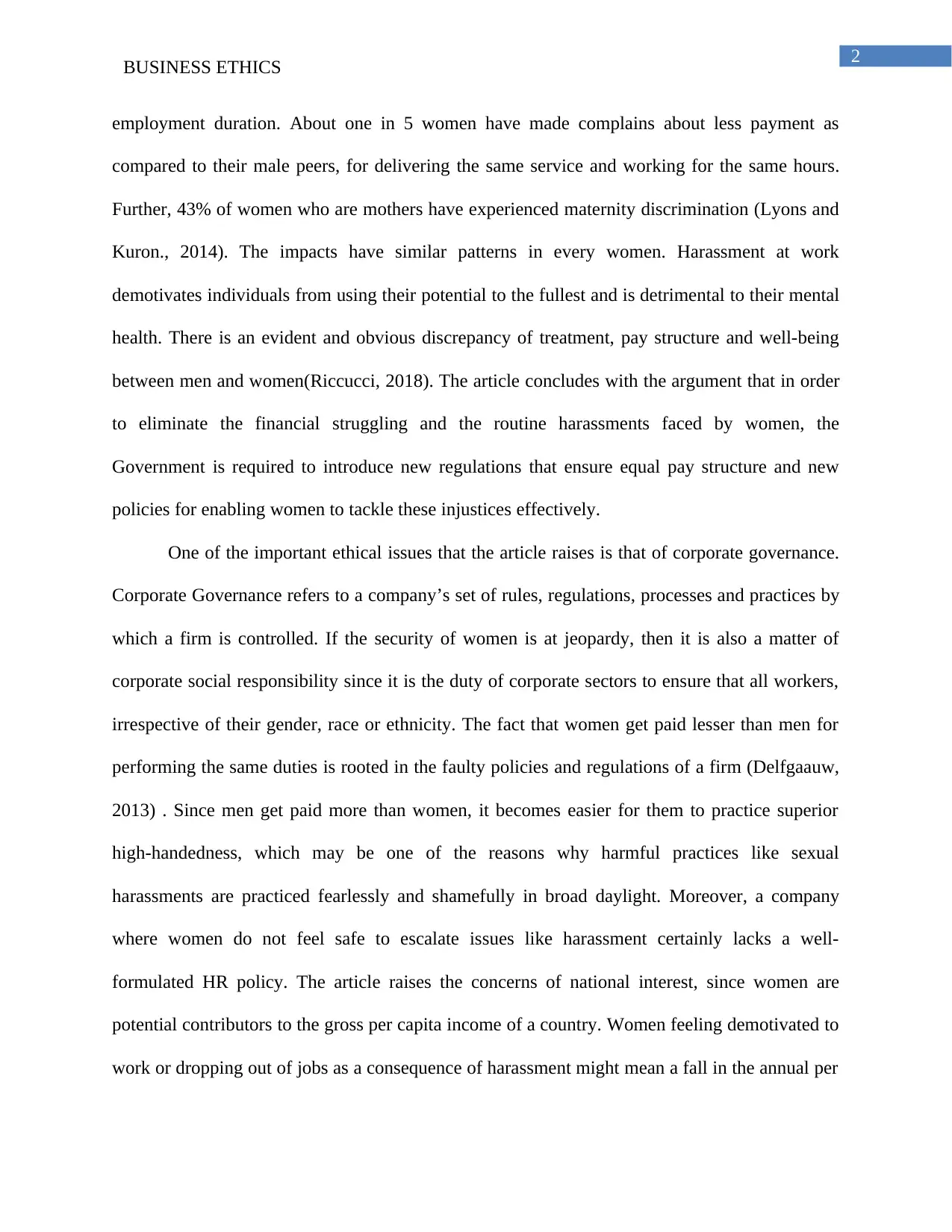
2
BUSINESS ETHICS
employment duration. About one in 5 women have made complains about less payment as
compared to their male peers, for delivering the same service and working for the same hours.
Further, 43% of women who are mothers have experienced maternity discrimination (Lyons and
Kuron., 2014). The impacts have similar patterns in every women. Harassment at work
demotivates individuals from using their potential to the fullest and is detrimental to their mental
health. There is an evident and obvious discrepancy of treatment, pay structure and well-being
between men and women(Riccucci, 2018). The article concludes with the argument that in order
to eliminate the financial struggling and the routine harassments faced by women, the
Government is required to introduce new regulations that ensure equal pay structure and new
policies for enabling women to tackle these injustices effectively.
One of the important ethical issues that the article raises is that of corporate governance.
Corporate Governance refers to a company’s set of rules, regulations, processes and practices by
which a firm is controlled. If the security of women is at jeopardy, then it is also a matter of
corporate social responsibility since it is the duty of corporate sectors to ensure that all workers,
irrespective of their gender, race or ethnicity. The fact that women get paid lesser than men for
performing the same duties is rooted in the faulty policies and regulations of a firm (Delfgaauw,
2013) . Since men get paid more than women, it becomes easier for them to practice superior
high-handedness, which may be one of the reasons why harmful practices like sexual
harassments are practiced fearlessly and shamefully in broad daylight. Moreover, a company
where women do not feel safe to escalate issues like harassment certainly lacks a well-
formulated HR policy. The article raises the concerns of national interest, since women are
potential contributors to the gross per capita income of a country. Women feeling demotivated to
work or dropping out of jobs as a consequence of harassment might mean a fall in the annual per
BUSINESS ETHICS
employment duration. About one in 5 women have made complains about less payment as
compared to their male peers, for delivering the same service and working for the same hours.
Further, 43% of women who are mothers have experienced maternity discrimination (Lyons and
Kuron., 2014). The impacts have similar patterns in every women. Harassment at work
demotivates individuals from using their potential to the fullest and is detrimental to their mental
health. There is an evident and obvious discrepancy of treatment, pay structure and well-being
between men and women(Riccucci, 2018). The article concludes with the argument that in order
to eliminate the financial struggling and the routine harassments faced by women, the
Government is required to introduce new regulations that ensure equal pay structure and new
policies for enabling women to tackle these injustices effectively.
One of the important ethical issues that the article raises is that of corporate governance.
Corporate Governance refers to a company’s set of rules, regulations, processes and practices by
which a firm is controlled. If the security of women is at jeopardy, then it is also a matter of
corporate social responsibility since it is the duty of corporate sectors to ensure that all workers,
irrespective of their gender, race or ethnicity. The fact that women get paid lesser than men for
performing the same duties is rooted in the faulty policies and regulations of a firm (Delfgaauw,
2013) . Since men get paid more than women, it becomes easier for them to practice superior
high-handedness, which may be one of the reasons why harmful practices like sexual
harassments are practiced fearlessly and shamefully in broad daylight. Moreover, a company
where women do not feel safe to escalate issues like harassment certainly lacks a well-
formulated HR policy. The article raises the concerns of national interest, since women are
potential contributors to the gross per capita income of a country. Women feeling demotivated to
work or dropping out of jobs as a consequence of harassment might mean a fall in the annual per
⊘ This is a preview!⊘
Do you want full access?
Subscribe today to unlock all pages.

Trusted by 1+ million students worldwide
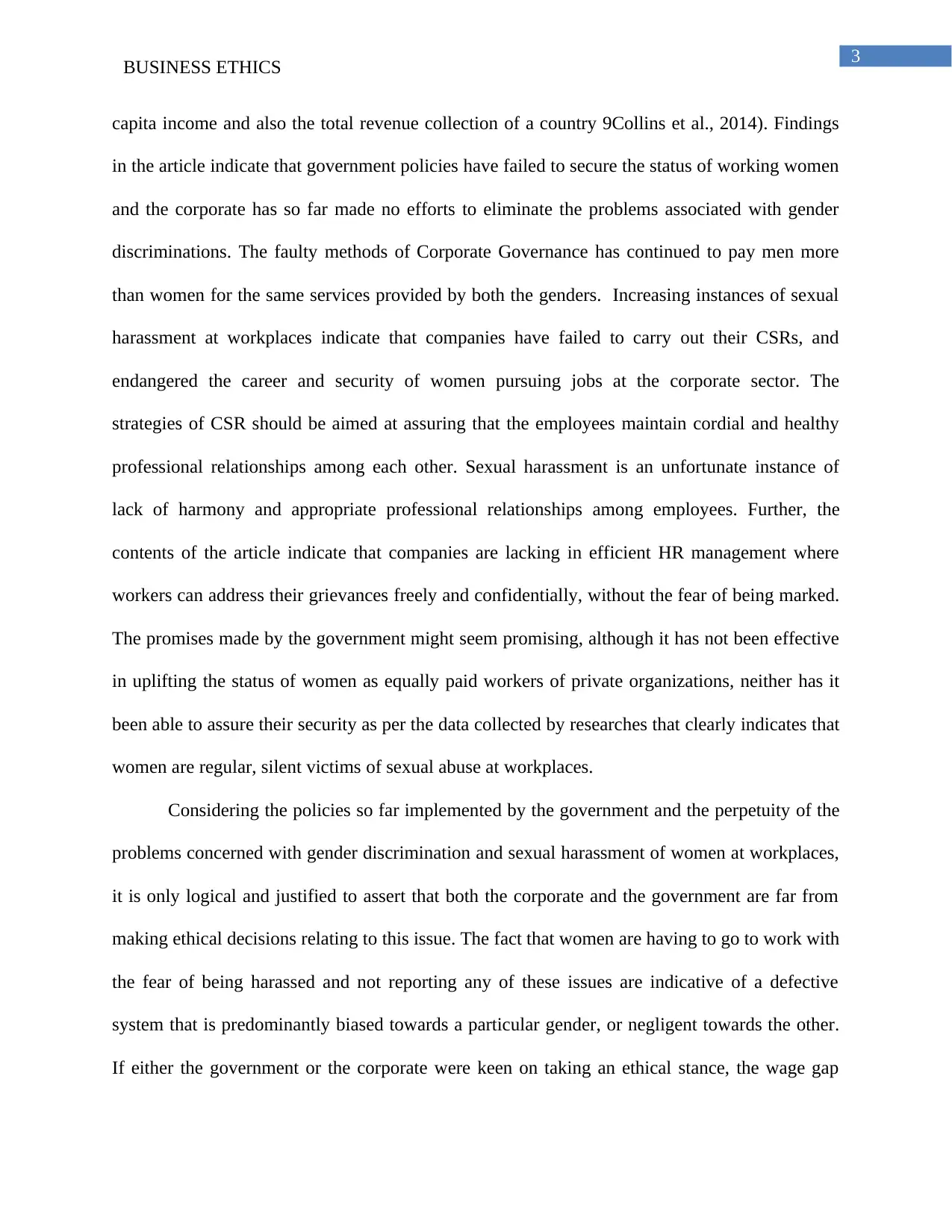
3
BUSINESS ETHICS
capita income and also the total revenue collection of a country 9Collins et al., 2014). Findings
in the article indicate that government policies have failed to secure the status of working women
and the corporate has so far made no efforts to eliminate the problems associated with gender
discriminations. The faulty methods of Corporate Governance has continued to pay men more
than women for the same services provided by both the genders. Increasing instances of sexual
harassment at workplaces indicate that companies have failed to carry out their CSRs, and
endangered the career and security of women pursuing jobs at the corporate sector. The
strategies of CSR should be aimed at assuring that the employees maintain cordial and healthy
professional relationships among each other. Sexual harassment is an unfortunate instance of
lack of harmony and appropriate professional relationships among employees. Further, the
contents of the article indicate that companies are lacking in efficient HR management where
workers can address their grievances freely and confidentially, without the fear of being marked.
The promises made by the government might seem promising, although it has not been effective
in uplifting the status of women as equally paid workers of private organizations, neither has it
been able to assure their security as per the data collected by researches that clearly indicates that
women are regular, silent victims of sexual abuse at workplaces.
Considering the policies so far implemented by the government and the perpetuity of the
problems concerned with gender discrimination and sexual harassment of women at workplaces,
it is only logical and justified to assert that both the corporate and the government are far from
making ethical decisions relating to this issue. The fact that women are having to go to work with
the fear of being harassed and not reporting any of these issues are indicative of a defective
system that is predominantly biased towards a particular gender, or negligent towards the other.
If either the government or the corporate were keen on taking an ethical stance, the wage gap
BUSINESS ETHICS
capita income and also the total revenue collection of a country 9Collins et al., 2014). Findings
in the article indicate that government policies have failed to secure the status of working women
and the corporate has so far made no efforts to eliminate the problems associated with gender
discriminations. The faulty methods of Corporate Governance has continued to pay men more
than women for the same services provided by both the genders. Increasing instances of sexual
harassment at workplaces indicate that companies have failed to carry out their CSRs, and
endangered the career and security of women pursuing jobs at the corporate sector. The
strategies of CSR should be aimed at assuring that the employees maintain cordial and healthy
professional relationships among each other. Sexual harassment is an unfortunate instance of
lack of harmony and appropriate professional relationships among employees. Further, the
contents of the article indicate that companies are lacking in efficient HR management where
workers can address their grievances freely and confidentially, without the fear of being marked.
The promises made by the government might seem promising, although it has not been effective
in uplifting the status of women as equally paid workers of private organizations, neither has it
been able to assure their security as per the data collected by researches that clearly indicates that
women are regular, silent victims of sexual abuse at workplaces.
Considering the policies so far implemented by the government and the perpetuity of the
problems concerned with gender discrimination and sexual harassment of women at workplaces,
it is only logical and justified to assert that both the corporate and the government are far from
making ethical decisions relating to this issue. The fact that women are having to go to work with
the fear of being harassed and not reporting any of these issues are indicative of a defective
system that is predominantly biased towards a particular gender, or negligent towards the other.
If either the government or the corporate were keen on taking an ethical stance, the wage gap
Paraphrase This Document
Need a fresh take? Get an instant paraphrase of this document with our AI Paraphraser
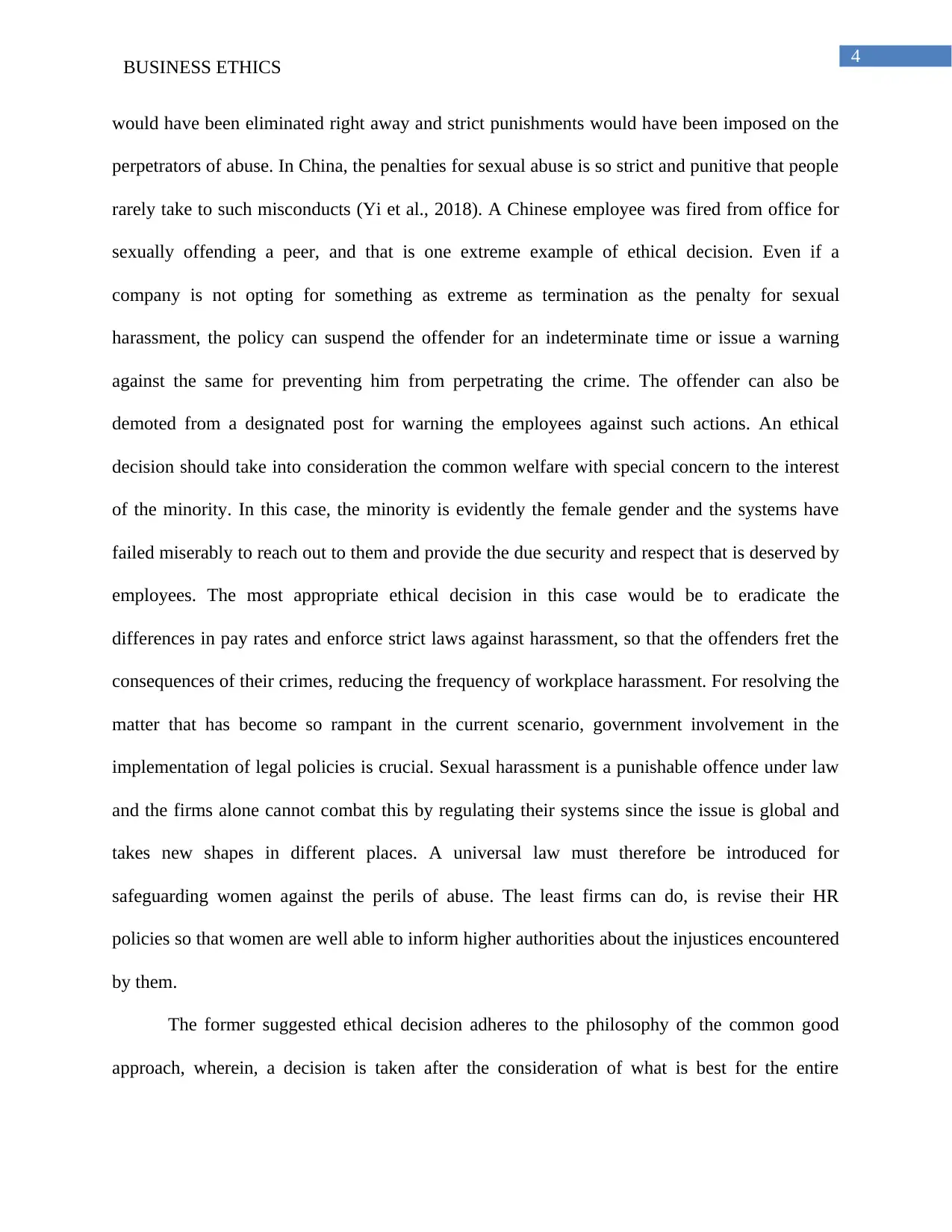
4
BUSINESS ETHICS
would have been eliminated right away and strict punishments would have been imposed on the
perpetrators of abuse. In China, the penalties for sexual abuse is so strict and punitive that people
rarely take to such misconducts (Yi et al., 2018). A Chinese employee was fired from office for
sexually offending a peer, and that is one extreme example of ethical decision. Even if a
company is not opting for something as extreme as termination as the penalty for sexual
harassment, the policy can suspend the offender for an indeterminate time or issue a warning
against the same for preventing him from perpetrating the crime. The offender can also be
demoted from a designated post for warning the employees against such actions. An ethical
decision should take into consideration the common welfare with special concern to the interest
of the minority. In this case, the minority is evidently the female gender and the systems have
failed miserably to reach out to them and provide the due security and respect that is deserved by
employees. The most appropriate ethical decision in this case would be to eradicate the
differences in pay rates and enforce strict laws against harassment, so that the offenders fret the
consequences of their crimes, reducing the frequency of workplace harassment. For resolving the
matter that has become so rampant in the current scenario, government involvement in the
implementation of legal policies is crucial. Sexual harassment is a punishable offence under law
and the firms alone cannot combat this by regulating their systems since the issue is global and
takes new shapes in different places. A universal law must therefore be introduced for
safeguarding women against the perils of abuse. The least firms can do, is revise their HR
policies so that women are well able to inform higher authorities about the injustices encountered
by them.
The former suggested ethical decision adheres to the philosophy of the common good
approach, wherein, a decision is taken after the consideration of what is best for the entire
BUSINESS ETHICS
would have been eliminated right away and strict punishments would have been imposed on the
perpetrators of abuse. In China, the penalties for sexual abuse is so strict and punitive that people
rarely take to such misconducts (Yi et al., 2018). A Chinese employee was fired from office for
sexually offending a peer, and that is one extreme example of ethical decision. Even if a
company is not opting for something as extreme as termination as the penalty for sexual
harassment, the policy can suspend the offender for an indeterminate time or issue a warning
against the same for preventing him from perpetrating the crime. The offender can also be
demoted from a designated post for warning the employees against such actions. An ethical
decision should take into consideration the common welfare with special concern to the interest
of the minority. In this case, the minority is evidently the female gender and the systems have
failed miserably to reach out to them and provide the due security and respect that is deserved by
employees. The most appropriate ethical decision in this case would be to eradicate the
differences in pay rates and enforce strict laws against harassment, so that the offenders fret the
consequences of their crimes, reducing the frequency of workplace harassment. For resolving the
matter that has become so rampant in the current scenario, government involvement in the
implementation of legal policies is crucial. Sexual harassment is a punishable offence under law
and the firms alone cannot combat this by regulating their systems since the issue is global and
takes new shapes in different places. A universal law must therefore be introduced for
safeguarding women against the perils of abuse. The least firms can do, is revise their HR
policies so that women are well able to inform higher authorities about the injustices encountered
by them.
The former suggested ethical decision adheres to the philosophy of the common good
approach, wherein, a decision is taken after the consideration of what is best for the entire
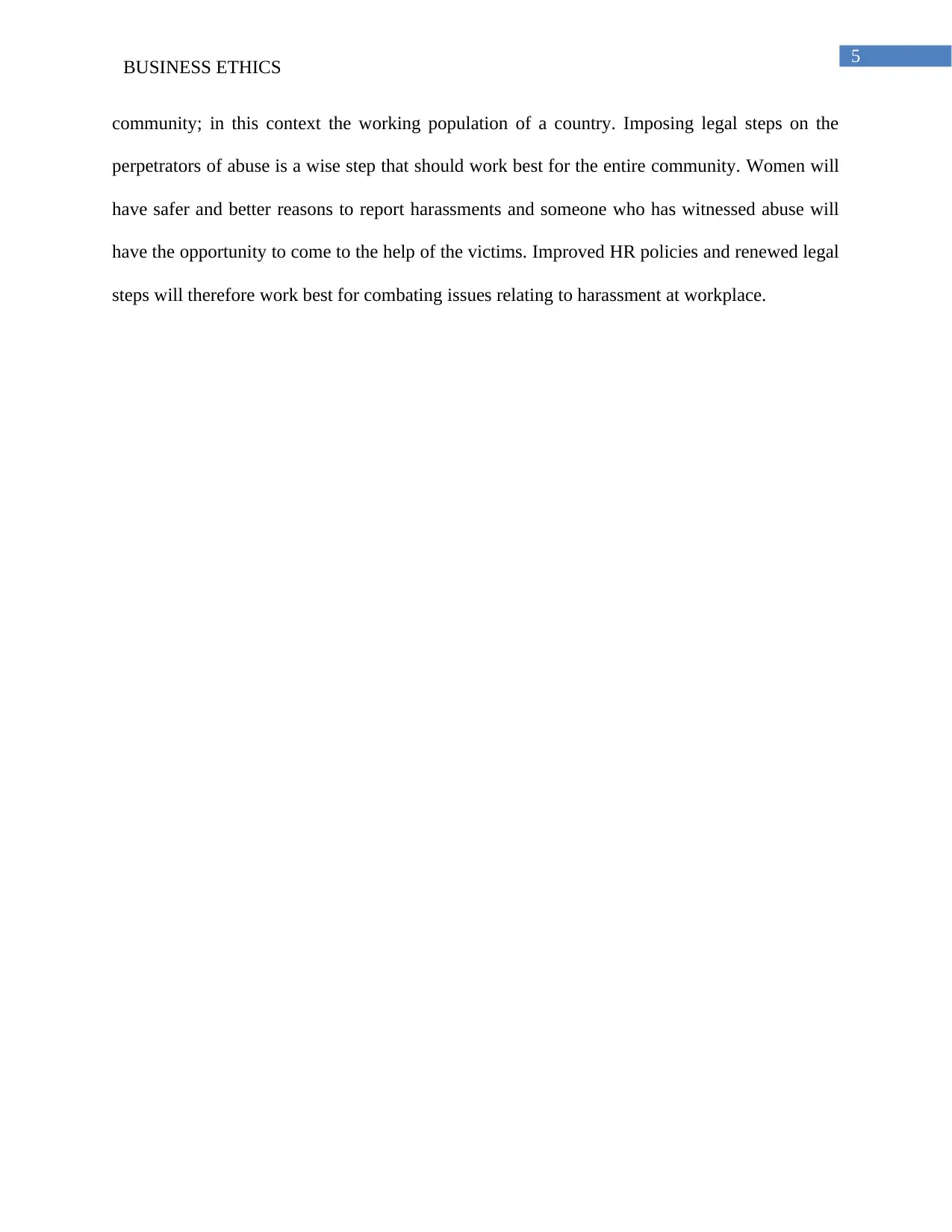
5
BUSINESS ETHICS
community; in this context the working population of a country. Imposing legal steps on the
perpetrators of abuse is a wise step that should work best for the entire community. Women will
have safer and better reasons to report harassments and someone who has witnessed abuse will
have the opportunity to come to the help of the victims. Improved HR policies and renewed legal
steps will therefore work best for combating issues relating to harassment at workplace.
BUSINESS ETHICS
community; in this context the working population of a country. Imposing legal steps on the
perpetrators of abuse is a wise step that should work best for the entire community. Women will
have safer and better reasons to report harassments and someone who has witnessed abuse will
have the opportunity to come to the help of the victims. Improved HR policies and renewed legal
steps will therefore work best for combating issues relating to harassment at workplace.
⊘ This is a preview!⊘
Do you want full access?
Subscribe today to unlock all pages.

Trusted by 1+ million students worldwide
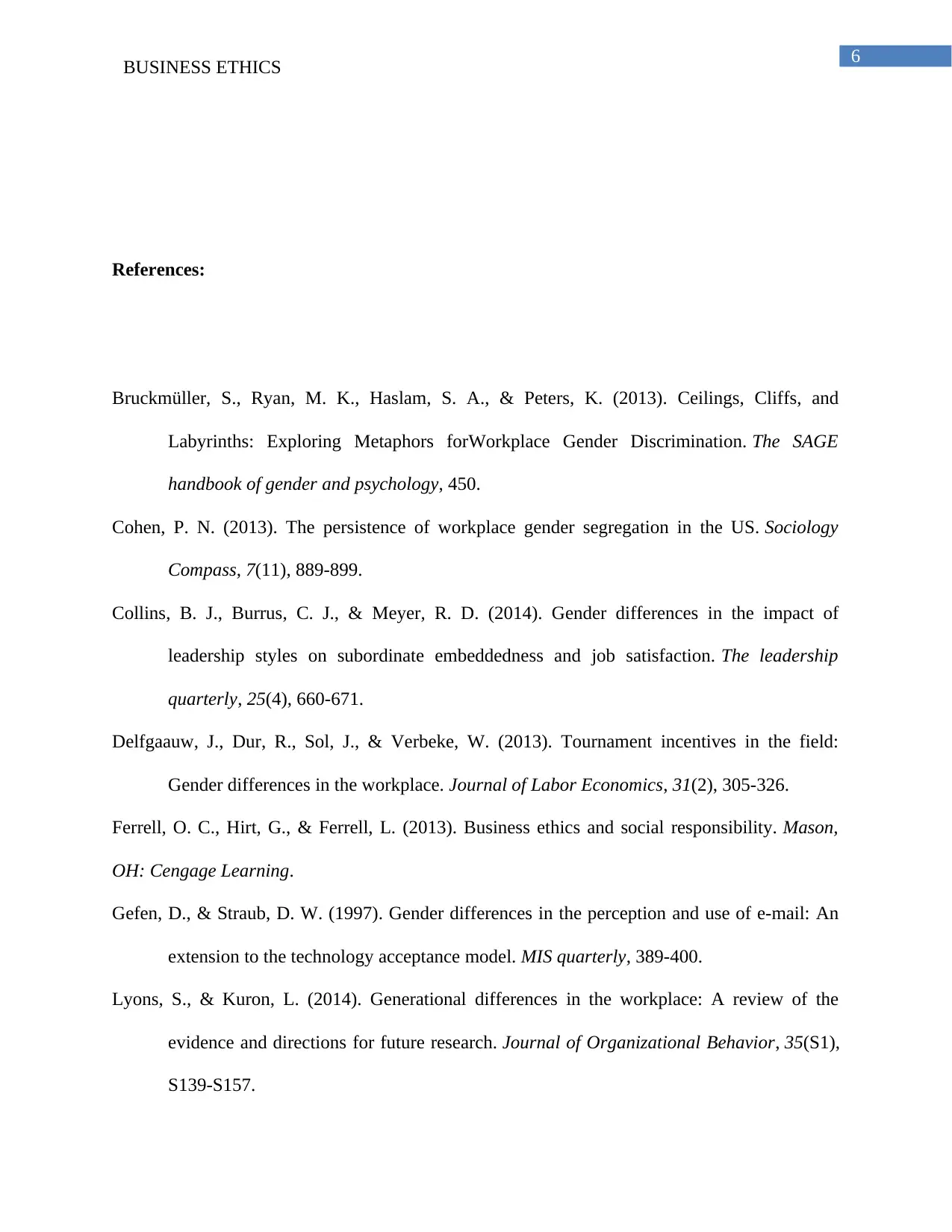
6
BUSINESS ETHICS
References:
Bruckmüller, S., Ryan, M. K., Haslam, S. A., & Peters, K. (2013). Ceilings, Cliffs, and
Labyrinths: Exploring Metaphors forWorkplace Gender Discrimination. The SAGE
handbook of gender and psychology, 450.
Cohen, P. N. (2013). The persistence of workplace gender segregation in the US. Sociology
Compass, 7(11), 889-899.
Collins, B. J., Burrus, C. J., & Meyer, R. D. (2014). Gender differences in the impact of
leadership styles on subordinate embeddedness and job satisfaction. The leadership
quarterly, 25(4), 660-671.
Delfgaauw, J., Dur, R., Sol, J., & Verbeke, W. (2013). Tournament incentives in the field:
Gender differences in the workplace. Journal of Labor Economics, 31(2), 305-326.
Ferrell, O. C., Hirt, G., & Ferrell, L. (2013). Business ethics and social responsibility. Mason,
OH: Cengage Learning.
Gefen, D., & Straub, D. W. (1997). Gender differences in the perception and use of e-mail: An
extension to the technology acceptance model. MIS quarterly, 389-400.
Lyons, S., & Kuron, L. (2014). Generational differences in the workplace: A review of the
evidence and directions for future research. Journal of Organizational Behavior, 35(S1),
S139-S157.
BUSINESS ETHICS
References:
Bruckmüller, S., Ryan, M. K., Haslam, S. A., & Peters, K. (2013). Ceilings, Cliffs, and
Labyrinths: Exploring Metaphors forWorkplace Gender Discrimination. The SAGE
handbook of gender and psychology, 450.
Cohen, P. N. (2013). The persistence of workplace gender segregation in the US. Sociology
Compass, 7(11), 889-899.
Collins, B. J., Burrus, C. J., & Meyer, R. D. (2014). Gender differences in the impact of
leadership styles on subordinate embeddedness and job satisfaction. The leadership
quarterly, 25(4), 660-671.
Delfgaauw, J., Dur, R., Sol, J., & Verbeke, W. (2013). Tournament incentives in the field:
Gender differences in the workplace. Journal of Labor Economics, 31(2), 305-326.
Ferrell, O. C., Hirt, G., & Ferrell, L. (2013). Business ethics and social responsibility. Mason,
OH: Cengage Learning.
Gefen, D., & Straub, D. W. (1997). Gender differences in the perception and use of e-mail: An
extension to the technology acceptance model. MIS quarterly, 389-400.
Lyons, S., & Kuron, L. (2014). Generational differences in the workplace: A review of the
evidence and directions for future research. Journal of Organizational Behavior, 35(S1),
S139-S157.
Paraphrase This Document
Need a fresh take? Get an instant paraphrase of this document with our AI Paraphraser
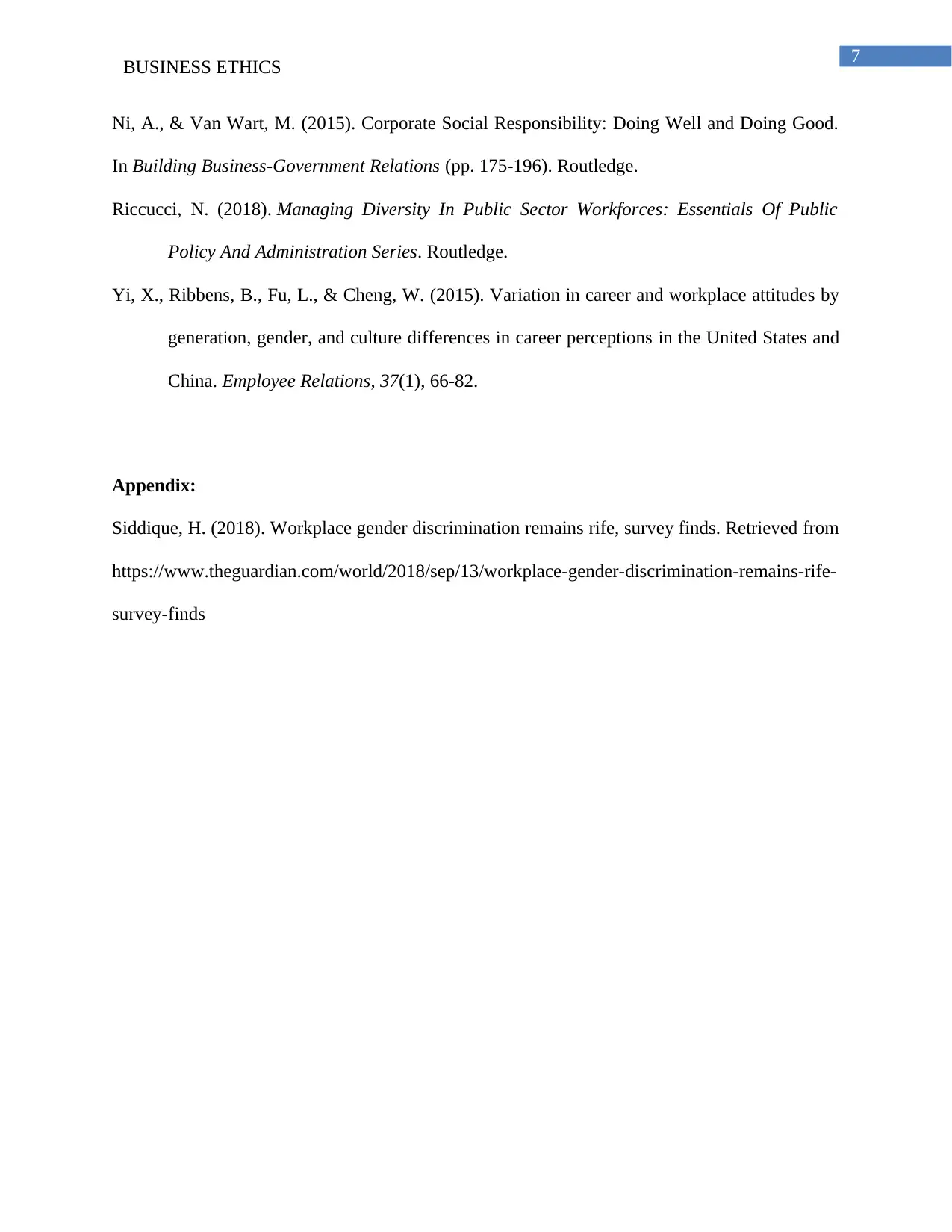
7
BUSINESS ETHICS
Ni, A., & Van Wart, M. (2015). Corporate Social Responsibility: Doing Well and Doing Good.
In Building Business-Government Relations (pp. 175-196). Routledge.
Riccucci, N. (2018). Managing Diversity In Public Sector Workforces: Essentials Of Public
Policy And Administration Series. Routledge.
Yi, X., Ribbens, B., Fu, L., & Cheng, W. (2015). Variation in career and workplace attitudes by
generation, gender, and culture differences in career perceptions in the United States and
China. Employee Relations, 37(1), 66-82.
Appendix:
Siddique, H. (2018). Workplace gender discrimination remains rife, survey finds. Retrieved from
https://www.theguardian.com/world/2018/sep/13/workplace-gender-discrimination-remains-rife-
survey-finds
BUSINESS ETHICS
Ni, A., & Van Wart, M. (2015). Corporate Social Responsibility: Doing Well and Doing Good.
In Building Business-Government Relations (pp. 175-196). Routledge.
Riccucci, N. (2018). Managing Diversity In Public Sector Workforces: Essentials Of Public
Policy And Administration Series. Routledge.
Yi, X., Ribbens, B., Fu, L., & Cheng, W. (2015). Variation in career and workplace attitudes by
generation, gender, and culture differences in career perceptions in the United States and
China. Employee Relations, 37(1), 66-82.
Appendix:
Siddique, H. (2018). Workplace gender discrimination remains rife, survey finds. Retrieved from
https://www.theguardian.com/world/2018/sep/13/workplace-gender-discrimination-remains-rife-
survey-finds
1 out of 8
Related Documents
Your All-in-One AI-Powered Toolkit for Academic Success.
+13062052269
info@desklib.com
Available 24*7 on WhatsApp / Email
![[object Object]](/_next/static/media/star-bottom.7253800d.svg)
Unlock your academic potential
Copyright © 2020–2025 A2Z Services. All Rights Reserved. Developed and managed by ZUCOL.




